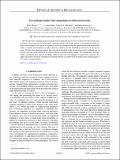Files in this item
Two-pathogen model with competition on clustered networks
Item metadata
| dc.contributor.author | Mann, Peter Stephen | |
| dc.contributor.author | Smith, V.A. | |
| dc.contributor.author | Mitchell, John B. O. | |
| dc.contributor.author | Dobson, Simon Andrew | |
| dc.date.accessioned | 2021-06-18T08:30:02Z | |
| dc.date.available | 2021-06-18T08:30:02Z | |
| dc.date.issued | 2021-06-17 | |
| dc.identifier | 274300187 | |
| dc.identifier | ae2a860e-9771-481d-8b74-ad456bb2c801 | |
| dc.identifier | 000663307700002 | |
| dc.identifier | 85108739937 | |
| dc.identifier.citation | Mann , P S , Smith , V A , Mitchell , J B O & Dobson , S A 2021 , ' Two-pathogen model with competition on clustered networks ' , Physical Review. E, Statistical, nonlinear, and soft matter physics , vol. 103 , no. 6 , 062308 . https://doi.org/10.1103/PhysRevE.103.062308 | en |
| dc.identifier.issn | 1539-3755 | |
| dc.identifier.other | ORCID: /0000-0002-0379-6097/work/95772310 | |
| dc.identifier.other | ORCID: /0000-0002-0487-2469/work/95772395 | |
| dc.identifier.other | ORCID: /0000-0001-9633-2103/work/95772422 | |
| dc.identifier.uri | https://hdl.handle.net/10023/23386 | |
| dc.description.abstract | Networks provide a mathematically rich framework to represent social contacts sufficient for the transmission of disease. Social networks are often highly clustered and fail to be locally tree-like. In this paper, we study the effects of clustering on the spread of sequential strains of a pathogen using the generating function formulation under a complete cross-immunity coupling, deriving conditions for the threshold of coexistence of the second strain. We show that clustering reduces the coexistence threshold of the second strain and its outbreak size in Poisson networks, whilst exhibiting the opposite effects on uniform-degree models. We conclude that clustering within a population must increase the ability of the second wave of an epidemic to spread over a network. We apply our model to the study of multilayer clustered networks and observe the fracturing of the residual graph at two distinct transmissibilities. | |
| dc.format.extent | 8 | |
| dc.format.extent | 526408 | |
| dc.language.iso | eng | |
| dc.relation.ispartof | Physical Review. E, Statistical, nonlinear, and soft matter physics | en |
| dc.subject | Complex networks | en |
| dc.subject | Percolation | en |
| dc.subject | Epidemic spreading | en |
| dc.subject | Co-infection | en |
| dc.subject | Clustered networks | en |
| dc.subject | QA75 Electronic computers. Computer science | en |
| dc.subject | RA0421 Public health. Hygiene. Preventive Medicine | en |
| dc.subject | T-NDAS | en |
| dc.subject | SDG 3 - Good Health and Well-being | en |
| dc.subject.lcc | QA75 | en |
| dc.subject.lcc | RA0421 | en |
| dc.title | Two-pathogen model with competition on clustered networks | en |
| dc.type | Journal article | en |
| dc.contributor.institution | University of St Andrews. School of Chemistry | en |
| dc.contributor.institution | University of St Andrews. Office of the Principal | en |
| dc.contributor.institution | University of St Andrews. St Andrews Centre for Exoplanet Science | en |
| dc.contributor.institution | University of St Andrews. Centre for Biological Diversity | en |
| dc.contributor.institution | University of St Andrews. Scottish Oceans Institute | en |
| dc.contributor.institution | University of St Andrews. Institute of Behavioural and Neural Sciences | en |
| dc.contributor.institution | University of St Andrews. School of Biology | en |
| dc.contributor.institution | University of St Andrews. St Andrews Bioinformatics Unit | en |
| dc.contributor.institution | University of St Andrews. EaSTCHEM | en |
| dc.contributor.institution | University of St Andrews. Biomedical Sciences Research Complex | en |
| dc.contributor.institution | University of St Andrews. School of Computer Science | en |
| dc.contributor.institution | University of St Andrews. Sir James Mackenzie Institute for Early Diagnosis | en |
| dc.identifier.doi | https://doi.org/10.1103/PhysRevE.103.062308 | |
| dc.description.status | Peer reviewed | en |
| dc.identifier.url | https://arxiv.org/abs/2007.03287 | en |
This item appears in the following Collection(s)
Items in the St Andrews Research Repository are protected by copyright, with all rights reserved, unless otherwise indicated.

